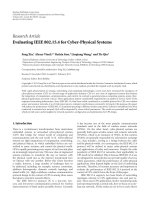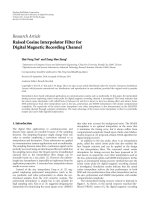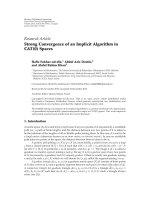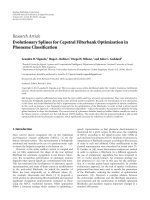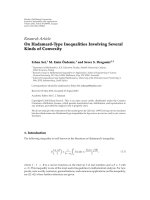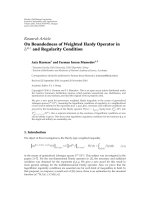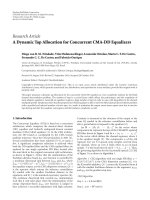Báo cáo hóa học: " Research Article Throughput Gain Using Threshold-Based Multiuser Scheduling in WiMAX OFDMA" pot
Bạn đang xem bản rút gọn của tài liệu. Xem và tải ngay bản đầy đủ của tài liệu tại đây (623.25 KB, 7 trang )
Hindawi Publishing Corporation
EURASIP Journal on Wireless Communications and Networking
Volume 2011, Article ID 941350, 7 pages
doi:10.1155/2011/941350
Research Article
Throughput Gain Using Threshold-Based
Multiuser Scheduling in WiMAX OFDMA
Ahmed Iyanda Sulyman
Department of Electrical Engineering, College of Engineering, King Saud University, Riyadh 11421, Saudi Arabia
Correspondence should be addressed to Ahmed Iyanda Sulyman,
Received 5 October 2010; Revised 13 January 2011; Accepted 18 February 2011
Academic Editor: Stefan Kaiser
Copyright © 2011 Ahmed Iyanda Sulyman. This is an open access article distributed under the Creative Commons Attribution
License, which permits unrestricted use, distribution, and reproduction in any medium, provided the original work is properly
cited.
This paper presents the analysis of the throughput enhancement possible using threshold-based multiuser scheduling in WiMAX
OFDMA. We consider a point-to-multipoint (PMP) WiMAX network where base station (BS) schedules downlink packets for
simultaneous transmissions to multiple users using the WiMAX OFDMA system. WiMAX OFDMA standard specifies several
subcarrier permutation options, such as the partial usage of subcarriers (PUSC), full usage of subcarrier (FUSC), and the band
adaptive modulation and coding (band-AMC) among others, for mapping the physical subcarriers into logical subchannels
assigned to users by the BS schedulers. In this paper, we propose the use of threshold testing prior to the process of subchannel
assignment to users by the BS scheduler, as a means of throughput enhancement. In the proposed threshold-based multiuser
scheduling scheme, the BS scheduler selects at any time instant users whose channel gains in the available subchannels equal or
exceed a predetermined energy threshold. Thus, only users who can maximize BS throughput on the available subchannels are
assigned data transmission opportunities which enhance the BS data rate, albeit at the expense of fairness to users. We quantify
the throughput enhancement of the proposed system and illustrate its benefits by numerical simulations.
1. Introduction
The IEEE 802.16 standard-based WiMAX network speci-
fies OFDMA (orthogonal frequency division multiplexing
access) as multiuser access method, where a base station (BS),
in a point-to-multipoint (PMP) mode, communicates with
multiple users simultaneously on different time-frequency
resources [1–5]. Each subchannel in the OFDMA option of
the WiMAX system comprises a set of OFDM subcarriers
which may be mapped onto the frequency spectrum either
sequentially or in a pseudorandom manner. In the randomly
mapped system such as the full usage of subcarriers (FUSC)
and the partial usage of subcarriers (PUSC), the subcarriers
in a subchannel are taken from different portions of the
spectrum either in a completely pseudorandom manner
(FUSC system) or by randomly selecting different subcarrier
groups, each consisting of adjacent subcarriers in the fre-
quency spectrum, into a subchannel (PUSC system). In the
sequentially mapped system such as band adaptive modula-
tion and coding (band-AMC), only subcarriers adjacent in
the frequency spectrum are included in a subchannel.
In this paper, we consider the use of threshold-based
multiuser scheduling in WiMAX OFDMA. Threshold-based
scheduling is applicable to all the WiMAX subcarrier per-
mutation options, but due to analytical difficulty we will
later focus on the band-AMC in our analysis. Motivation
for the threshold-based scheduling consideration is the fact
that, in OFDMA systems, user channels experience deep
fades frequently, therefore the regular WiMAX OFDMA
scheduler based on FUSC, PUSC, or band-AMC systems
would be forced to assign subchannels to users when
their channels experience deep fades, degrading the BS
throughput significantly. To optimize BS throughput in such
case, we propose in this paper the use of threshold-based
multiuser scheduling, where users first undergo threshold
test before the regular scheduling policy of the BS is applied.
The threshold-based selection method was proposed by
Sulyman and Kousa in [6] for diversity combining problem
in a single-user transmission system, and has been widely
studied in the literature [7–10]. In the context of multiuser
scheduling in WiMAX network, we recently discuss the
use of threshold-based multiuser scheduling, where a BS
2 EURASIP Journal on Wireless Communications and Networking
Wireless
channel
Active
users
User 1
User 2
User L
γ
1
γ
2
γ
L
.
.
.
DL resources
Time slots
Feedback path
BS
Queue
buffer at BS
User data
12
··· L
1
.
.
.
N
e
OFDM
subchannels
Figure 1: Downlink scheduling in WiMAX OFDMA networks.
scheduler uses the energy threshold criterion to select
the users to be scheduled for downlink transmission at
any time instant in a WiMAX OFDMA system [11]. The
advantage of this scheduling strategy is that, at any time
instant, only users whose channels are strong enough to
sustain the network operator’s target data rate are scheduled.
This allows operators to maximize system throughput and
is more useful for non-real-time traffic, which are delay
tolerant. Scheduling of data transmissions to users with
temporarily weak channels can wait until their channel
conditions improve. Efficient utilization of the resources
for non-real-time traffic as proposed in this paper frees
up bandwidth resources for real-time trafficandoptimizes
overall network resource utilizations. In this paper we define
a performance metric called the throughput gain and analyze
this metric. We show that the throughput gain achieved in
the threshold-based multiuser scheduling scheme compared
to the regular scheduling system increases as the threshold
level is increased.
2. System Model and Analysis
2.1. System Model for Threshold-Based Scheduling. Consider
a threshold-based downlink scheduling scheme in OFDMA
system where a BS scheduler schedules n
i
users for downlink
transmission, out of total of L users, whose SNR on the
ith subchannel meet or exceed a predetermined energy
threshold, γth. The available N
c
subchannels in the OFDMA
system are distributed among the n
i
users (tagged here
active users) whose SNRs passed the threshold test, using
the regular BS scheduling policy. The number of users, n
i
,
satisfying the threshold requirement at any time instant
is not fixed but variable in correspondence with the user
channel statistics. The specific realization of n
i
could take
any value from the set
{1, 2, , L}, at each scheduling
period. Let
{γ
1
, γ
2
, , γ
L
} denote the instantaneous SNRs
of the L users fed back to the BS. At any time instant,
the BS scheduler schedules the users whose SNR γ
j
satisfy
γ
j
≥ γth, for downlink transmission, as illustrated in
Figure 1.
As proposed in [6], we define the threshold as
γth
= μ · max
γ
1
, γ
2
, , γ
L
,(1)
where 0
≤ μ ≤ 1. This threshold definition is tagged the
normalized threshold [8], and it insures that in the worst
case scenario at least one user will be scheduled for service,
while in cases when the fading is not severe such that all
users meet or exceed the threshold, they are all scheduled
for service. Thus, only users with good SNRs, γ
j
, to sustain
a desired data rate on the subchannels are scheduled at
any time instant [7]. Network operators can therefore use
the threshold definition to guarantee a desired data rate
on the overall network, optimizing the system throughput.
Threshold-based multiuser scheduling for μ
= 1reducesto
opportunistic scheduling, and, as μ is reduced, in the range
1 <μ<0, more users are scheduled per channel use,
introducing some fairness. The case μ
= 0 corresponds to
the regular underlying scheduling policy of the BS used as
reference.
2.2. Throughput Gain Analysis. The goal of an OFDMA
scheduler is the effective distribution of the OFDMA
subchannels among the active users in the cell such that
performance and costs are optimized. WiMAX OFDMA
standard describes several subcarrier permutation options
such as FUSC, PUSC, band-AMC, and, for the grouping
of the physical subcarriers into logical subchannels that
represents the unit of resource allocation to users by the BS
schedulers. Threshold-based scheduling is applicable to all
these subcarrier permutation options and can be used with
existing scheduling schemes implemented in the WiMAX
system. However, for each of the various subcarrier permu-
tation options, the statistics of the subcarriers grouped into a
subchannel differs. Thus, it is somewhat difficult to develop
a general analysis valid for all of them. To demonstrate the
potential benefits of the proposed threshold-based OFDMA
scheduler analytically, we choose a representative subcarrier
permutation option with tractable subchannel statistics, the
band-AMC scheme, and we develop analytical tool for
estimating the performance of the proposed scheme.
In this analysis, we examine the throughput gain
achievable using threshold-based selection for multiuser
scheduling in a WiMAX OFDMA system employing band-
AMC subcarrier permutation option. Assuming a burst of
length n OFDM symbols. At any time instant, the users
feedback to the BS their SNR in each subchannel, obtained
using the assigned pilots in the subchannels. The threshold-
based scheduler at the BS then conducts threshold test to
select the n
i
users whose SNRs, γ
1
, γ
2
, , γ
n
i
,areabove
threshold in the ith subchannel and schedules them in turn
(in round-robin manner, for example) for service on that
subchannel for n successive OFDM symbols transmitted in
a burst, where n
= max{n
1
, n
2
, , n
N
c
}. Without loss of
generality, we assume that n
1
= n
2
=···=n
N
c
= n
in the analysis. However, in practice, there would be cases
when n
i
< n for a given subchannel. For cases when n
i
<n
for a given subchannel, we assume that the BS scheduler
assigns the remaining time-frequency transmission resources
EURASIP Journal on Wireless Communications and Networking 3
γ
1
γ
2
γ
1
γ
2
γ
1
γ
2
γ
n
N
c
γ
1
γ
n
2
−1
γ
n
2
γ
n
1
−1
γ
n
1
12 n
N
c
2
1
n
N
c
<n
n
2
= n
n
1
= n
Burst of n OFDM symbols
N
c
subchannels
···
···
Figure 2: Threshold-based multiuser scheduling in WiMAX
OFDMA.
opportunistically by allocating them to the user with the best
SNR in that subchannel, as illustrated in Figure 2. The impact
of this assumption is that the throughput enhancements
estimated in the analysis are less than what would be
obtained in practice using threshold-based scheduling in
WiMAX OFDMA, as shown later in the simulation results
in Section 3.
For M-QAM transmissions over the subchannels in an
OFDM-based transmission, it is known that the achievable
data rate (upper bound on the throughput) is given by [12]
r
=
N
c
k=1
log
2
(
1+α
k
P
k
)
,(2)
where α
k
denotes the subchannel gain-to-noise ratio at the
receiver and P
k
denotes the transmitted power. The system
throughput is proportional to the per subchannel SNR of
service, given by γ
k
= α
k
P
k
, at any time instant. Thus, the
BS can enhance its throughput by scheduling only to users
with γ
k
above certain threshold in the kth subchannel. Define
the throughput enhancement on each subchannel due to
threshold-based multi-user scheduling as [11]
λ
Gain
=
E
[
SNRofservice
]
E
[
SNRofoneuser
]
. (3)
The throughput gain defined above gives a useful
measure of the throughput enhancement introduced by the
threshold testing in WiMAX OFDMA system in comparison
to the regular scheduling policies of the BS scheduler since
E[2
log
2
(1+γ
k
)
/2
log
2
(1+γ)
] ≈ (E[γ
k
])/γ ,whereγ
k
= α
k
P
k
denotes the SNR of the scheduled user (SNR of service) at
any time instant, and
γ denotes the average SNR in the cell.
In the ensuing analysis, we consider that all users experience
same average SNR
γ whichisapplicableinmultiuseraccess
problem where user channel statistics are i.i.d.
Let
{γ
l:L
}
L
l
=1
be the order statistics obtained by arrang-
ing the set of user SNRs
{γ
j
}
L
j
=1
in decreasing order of
magnitude, (i.e., γ
1:L
≥ γ
2:L
≥ ··· ≥ γ
n:L
≥ γ
n+1:L
≥
··· ≥
γ
L:L
). We assume that the set {γ
j
}
L
j
=1
is i.i.d.
Therefore, the joint probability distribution function (pdf ),
f
γ
1:L
, ,γ
L:L
(γ
1:L
, , γ
L:L
), of {γ
l:L
}
L
l
=1
is given by [13]
f
γ
1:L
, ,γ
L:L
γ
1:L
, , γ
L:L
=
L!
L
i=1
f
γ
γ
i:L
∞
>γ
1:L
≥ γ
2:L
≥ ≥ γ
L:L
> 0,
(4)
where f
γ
(γ) denotes the pdf of the random variables γ.
Consider the subset
{γ
l:L
}
n
l
=1
designating the n largest γ
j
’s
(corresponding to the n users with the best SNRs scheduled
for downlink transmission per spectrum access, n
≤ L). Then
the joint pdf, f
γ
1:L
, ,γ
n:L
(γ
1:L
, , γ
n:L
), of {γ
l:L
}
n
l
=1
, n ≤ L,can
be obtained as [13]
f
γ
1:L
,γ
2:L
, ,γ
n:L
γ
1:L
, γ
2:L
, , γ
n:L
=
γ
n:L
0
···
γ
n:L
γ
n+2:L
f
γ
1:L
,γ
2L
, ,γ
L:L
×
γ
1:L
, γ
2:L
, γ
L:L
dγ
n+1:L
, , dγ
L:L
= n!
⎛
⎝
L
n
⎞
⎠
F
γ
γ
n:L
L−n
n
l=1
f
γ
γ
l:L
,
γ
1:L
≥ γ
2:L
≥ ≥ γ
n:L
,
(5)
where
L
n
=
(L!/n!(L−n)!) denotes the binomial coefficient,
and F
γ
(γ) =
γ
0
f
γ
(γ)dγ is the cumulative distribution
function (cdf) of the random variables γ
j
’s. We consider
that the underlying user channels experience Rayleigh fading,
therefore the
{γ
j
}
L
j
=1
are exponentially distributed, with pdf,
f
X
(x), and cdf, F
γ
(γ), given by
f
γ
γ
=
a exp
−
aγ
,
F
γ
γ
=
1 − exp
−
aγ
,
(6)
where
a
=
1
E
γ
j
=
1
γ
. (7)
To compute the throughput enhancement for the
threshold-based scheduling, we first condition on a fixed n
and write an expression for the average SNR of service given
n,as
E
[
SNRofservice
| n
]
= E
γ
1:L
,γ
2:L
, ,γ
n:L
⎡
⎣
1
n
⎛
⎝
n
l=1
γ
l:L
⎞
⎠
|
n
⎤
⎦
=
ϕ
(
n
)
.
(8)
Thus,
E
[
SNR of service
]
=
L
n=1
ϕ
(
n
)
· Pr
(
n = n
)
,(9)
where Pr(n
= n) denotes the probability that there are n users
whose SNR equal or exceed γth
= μγ
1:L
.
4 EURASIP Journal on Wireless Communications and Networking
To c o m p u t e P r ( n
= n), we first observe that the event
that the random variable n
= n occurs when the following
conditions are simultaneously satisfied [7–11]
μγ
1:L
≤ γ
2:L
≤ γ
1:L
,
μγ
1:L
≤ γ
3:L
≤ γ
2:L
, , μγ
1:L
≤ γ
n:L
≤ γ
n−1:L
,
0
≤ γ
n+1:L
≤ μγ
1:L
,
0
≤ γ
n+2:L
≤ γ
n+1:L
, ,0≤ γ
L:L
≤ γ
L−1:L
.
(10)
Using (4)and(10), we compute Pr(n
= n)as
Pr
(
n
= n
)
= L!
∞
0
f
γ
γ
1:L
dγ
1:L
γ
1:L
μγ
1:L
f
γ
γ
2:L
dγ
2:L
×
γ
2:L
μγ
1:L
f
γ
γ
3:L
dγ
3:L
···
γ
n−1:L
μγ
1:L
f
γ
γ
n:L
dγ
n:L
×
μγ
1:L
0
f
γ
γ
n+1:L
dγ
n+1:L
×
γ
n+1:L
0
f
γ
γ
n+2:L
dγ
n+2:L
···
γ
L−1:L
0
f
γ
γ
L:L
dγ
L:L
= n
⎛
⎝
L
n
⎞
⎠
L−n
i=0
(
−1
)
i
⎛
⎝
L − n
i
⎞
⎠
n−1
j=0
(
−1
)
j
⎛
⎝
n − 1
j
⎞
⎠
·
1
1+j + μ
n − 1 − j + i
.
(11)
Also using (5), we compute ϕ(n)as
ϕ
(
n
)
=
1
n
∞
0
∞
γ
n:L
···
∞
γ
2:L
⎛
⎝
n
l=1
γ
l:L
⎞
⎠
×
f
γ
1:L
,γ
2:L
, ,γ
n:L
×
γ
1:L
, γ
2:L
, , γ
n:L
dγ
1:L
···dγ
n−1:L
dγ
n:L
=
1
n
∞
0
∞
γ
n:L
···
∞
γ
2:L
⎛
⎝
n
l=1
γ
l:L
⎞
⎠
n!
×
⎛
⎝
L
n
⎞
⎠
1 − exp
−aγ
n:L
L−n
·
n
l=1
a exp
−
aγ
1:L
dγ
1:L
···dγ
n:L
.
(12)
To s o l v e ( 12), we consider the transformation of the
random variables
{γ
l:L
}
n
l
=1
obtained by defining the spacing
[13]
Y
1
= X
1:L
− X
2:L
,
Y
2
= X
2:L
− X
3:L
,
.
.
.
Y
n−1
= X
n−1:L
− X
n:L
,
Y
n
= X
n:L
.
(13)
It can be shown that the random variables Y
1
, Y
2
, , Y
n
are all statistically independent, with pdf given by
f
Y
1
y
1
=
al exp
−aly
1
, (14)
where y
l
≥ 0, l = 1, , n.
Using (13), (14), and (12) can be expressed as
ϕ
(
n
)
=
1
n
∞
0
···
∞
0
⎛
⎝
n
l=1
ly
l
⎞
⎠
n!
⎛
⎝
L
n
⎞
⎠
1 − exp
−ay
n
L−n
·
n
l=1
exp
−aly
l
day
1
···day
n
=
1
n
n!
(
a
)
n
⎛
⎝
L
n
⎞
⎠
n−1
k=1
·
⎡
⎣
∞
0
ky
k
exp
−
aky
k
dy
k
·
n−1
l=1,l
/
= k
∞
0
exp
−
aly
l
dy
l
·
∞
0
exp
−
any
n
1 − exp(−ay
n
)
L−n
dy
n
⎤
⎦
+
1
n
n!
(
a
)
n
⎛
⎝
L
n
⎞
⎠
·
∞
0
ny
n
exp
−any
n
1 − exp(−ay
n
)
L−n
dy
n
·
n−1
l=1
∞
0
exp
−
aly
l
dy
l
.
(15)
Solving the integrals in (15), we arrive at the following
final closed-form results, after some algebra
ϕ
(
n
)
=
(
n
− 1
)
!
(
a
)
n
⎛
⎝
L
n
⎞
⎠
·
n−1
k=1
⎡
⎣
1
a
1
ak
n−1
l=1,l
/
= k
1
al
1
an
L
n
⎤
⎦
+
(
n − 1
)
!
(
a
)
n
⎛
⎝
L
n
⎞
⎠
·
⎛
⎝
n
a
2
L
−n
k=0
(
−1
)
L−n+k
⎛
⎝
L − n
k
⎞
⎠
1
(
L
− k
)
2
⎞
⎠
·
n−1
l=1
1
al
.
(16)
EURASIP Journal on Wireless Communications and Networking 5
Using (1), (7), (9), (11), and (16), we obtain an expression
for the throughput gain using threshold-based scheduling as
λ
Gain
=
l
n=1
⎛
⎝
(
n
− 1
)
!
1
γ
n+1
⎛
⎝
L
n
⎞
⎠
·
n−1
k=1
⎡
⎣
γ
2
k
n−1
l=1,l
/
= k
γ
l
γ
n
L
n
⎤
⎦
·
Pr
(
n
)
+
(
n − 1
)
!
1
γ
n+1
⎛
⎝
L
n
⎞
⎠
.
⎛
⎝
γ
2
n
L−n
k=0
(
−1
)
L−n+k
⎛
⎝
L − n
k
⎞
⎠
1
(
L
− k
)
2
⎞
⎠
·
n−1
l=1
γ
l
·
Pr
(
n
)
⎞
⎠
,
(17)
where Pr(n)isgivenby (11).
3. Simulation Results
In Figure 3, we plot the analytical results for the per
subchannel throughput gain of threshold-based multiuser
scheduling schemes in OFDMA systems, using (11)and
(17). Simulation results are also included in this figure for
reference. For the illustrations in the figure, we assume
round-robin as the underlying BS scheduling policy upon
which threshold testing is applied. Both the analytical and
simulation results in the figure agree closely and indicate
that a multiuser scheduling system where users SNRs, γ
j
,
undergo threshold test before scheduling, would enhance
system throughput significantly as the threshold level is
increased in the range 0 <μ
≤ 1 (0%–100% threshold). The
enhancement becomes very significant when the number
of users serviced per base station sector is large, taking
advantage of the randomness of the user channel statistics.
For example for the 16-user system in this figure, about
2.5 dB throughput gain per OFDM subchannel can be
achieved for moderate threshold level such as μ
= 0.25, while
about 5 dB gain per-subchannel can be achieved with high
threshold level such as μ
= 0.9. These gains can be very
significant in systems with large number of subchannels per
OFDM symbol (e.g., IEEE 802.16e OFDMA option with 32
subchannels [5]).
Notice that at low threshold level, more numbers of
users are scheduled per OFDM symbol, allowing the BS to
exhibit more fairness to the users in the scheduling policy,
while at high threshold level less numbers of users are
scheduled per OFDM symbol, allowing the BS to exhibit
less fairness to the users. There is therefore an important
tradeoff between fairness and throughput enhancement in
the proposed scheme. We conduct an optimization search
for this tradeoff for the cases of sixteen, eight and four
users per BS scheduler, and the results are as summarized
in Figures 4 and 5. In Figure 4, we plot the average number
of users scheduled in the proposed scheme, E[n], while in
161412108642
Users
0
1
2
3
4
5
6
Average throughput gain (dB)
Theory
Simulation
μ
= 0.9
μ
= 0.5
μ
= 0.25
μ
= 0.1
Figure 3: Throughput enhancement using threshold-based mul-
tiuser scheduling in WiMAX OFDMA (16 users per BS scheduler).
Figure 5 we plot the average throughput gain, λ
Gain
,for
threshold range 0
≤ μ ≤ 1. It is observed from these
figures that while the throughput enhancements increase
with μ, the average number of users scheduled decreases with
it. An optimum value of μ thus exists for each case that
allows the BS scheduler to achieve reasonable throughput
enhancements while maintaining good level of fairness to the
users. Using these two figures, network operators can plan a
desired throughput enhancement (in dB) in their network,
and be able to estimate the level of user fairness compromised
doing so (in % of subscribed users serviced per BS downlink
transmission).
Examples. Suppose that a BS scheduler desires to enhance
its throughput while exhibiting 50% user fairness for the 4-
user case in Figure 4, which corresponds to E[n]
= 2.0. The
value of μ that achieves this is obtained from the figure as μ
=
0.45. Using this value of μ to read the corresponding estimate
of the throughput enhancement for the 4-user case from
Figure 5,weobtainλ
Gain
= 2.65 dB. Similarly suppose that
it is desired to enhance the BS throughput while exhibiting
56% user fairness for the 8-user case in Figure 4,which
corresponds to E[n]
= 4.5. The value of μ that achieves this
is obtained from the figure as μ
= 0.24. Using this value
of μ to read the corresponding estimate of the throughput
enhancement for the 8-user case from Figure 5,weobtain
λ
Gain
= 2.32 dB. Finally suppose it is desired to enhance the
BS throughput while exhibiting 80% user fairness for the 16-
user case in Figure 4, which corresponds to E[n]
= 12.8. The
value of μ that achieves this is obtained from the figure as
μ
= 0.07. Using this value of μ to read the corresponding
estimate of the throughput enhancement for the 16-user case
from Figure 5,weobtainλ
Gain
= 0.93 dB. Going higher above
the threshold level illustrated for each of the cases in this
example achieves more throughput enhancements but at the
expense of user fairness, since less number of users will be
scheduled per OFDM symbol transmitted by the BS.
6 EURASIP Journal on Wireless Communications and Networking
10.80.60.40.20
(μ)
0
2
4
6
8
10
12
14
16
Average number of users scheduled E[n]
Average number of users (4 users)
Average number of users (8 users)
Average number of users (16 users)
Figure 4: Average number of user scheduled per transmission with
respect to threshold level (4, 8, and 16 users per BS scheduler).
10.80.60.40.20
(μ)
0
1
2
3
4
5
6
7
Average throughput gain (dB)
Average throughput gain (4 users)
Average throughput gain (8 users)
Average throughput gain (16 users)
Figure 5: Throughput gain with respect to threshold level (4, 8, and
16 users per BS scheduler).
4. Conclusion
This paper presents the analysis of the throughput gain
achievable in a threshold-based multiuser scheduling scheme
in WiMAX OFDMA systems. We consider a point-to-
multipoint (PMP) WiMAX network where BS schedules
downlink packets for simultaneous transmissions to multiple
users using the WiMAX OFDMA system. In the threshold-
based scheduling scheme, the BS scheduler selects at any
time instant users whose channel gains in the available sub-
channels equal or exceed a predetermined energy threshold.
Thus, only users who can maximize data rate on the available
subchannels are scheduled, enhancing the BS throughput.
We quantify analytically the throughput gain per subchan-
nel, provided by the proposed scheme and also present
simulation results to verify the analysis. Both analysis and
simulations indicate significant enhancements in the system
throughput when large numbers of users are serviced per
BS scheduler. We also found that throughput enhancements
in the proposed scheme increases with the threshold while
average number of users scheduled per transmission (fairness
criterion) decreases with it. Therefore we illustrate methods
to obtain a threshold that achieves a reasonable balance on
this tradeoff for different numbers of users per BS scheduler.
It is expected that the preliminary results presented in
this paper will motivate further interests on the benefits
of the proposed scheduling scheme in WiMAX networks.
Specifically, we hope that the proposed scheme could provide
a simpler, yet efficient, alternative to the weighted round-
robin (WRR) scheduling scheme currently implemented in
WiMAX networks [14, 15].
Acknowledgments
The author thanks the editor and all anonymous reviewers
who examined this paper, for their constructive inputs. The
author also thanks the research centre at the college of
Engineering, King Saud University (KSU), for facilitating
this work. This work is sponsored by the Deanship of
Scientific Research, KSU, Riyadh, Saudi Arabia, under Grant
no. 150117.
References
[1] M. Guizani, M. Hamdi, P. Lorenz, and M. Ma, “Wireless
broadband access: WiMAX and beyond,” IEEE Communica-
tions Magazine, vol. 45, no. 12, pp. 60–61, 2007.
[2] Z.Abichar,Y.Peng,andJ.M.Chang,“WiMAX:theemergence
of wireless broadband,” IT Professional, vol. 8, no. 4, pp. 44–48,
2006.
[3] M. Mehrjoo, M. Dianati, X. Shen, and K. Naik, “Opportunistic
fair scheduling for the downlink of IEEE 802.16 wireless
Metropolitan area networks,” in Proceedings of the 3rd ACM
International Conference on Quality of Service in Heteroge-
neous Wired/Wireless Networks, ACM Press, Waterloo, Canada,
August 2006.
[4] M. Einhaus and O. Klein, “Performance evaluation of a basic
OFDMA scheduling algorithm for packet data transmissions,”
in Proceedings of the 11th IEEE Symposium on Computers and
Communications (ISCC ’06), pp. 695–701, June 2006.
[5] “IEEE Standard for Local and Metropolitan Area Networks—
Parts 16: Air Interface for Fixed and Mobile Broadband
Wireless Access System Amendment2: Physical and Medium
Access Control Layers for Combined Fixed and Mobile
Operation in Licensed Bands” February 2006.
[6] A. I. Sulyman and M. Kousa, “Bit error rate performance
of a generalized diversity selection combining scheme in
Nakagami fading channels,” in Proceedings of the IEEE Wireless
Communications and Networking Conference, pp. 1080–1085,
September 2000.
[7] A. I. Sulyman and M. Kousa, “Bit error rate performance
analysis of a threshold-based generalized selection combining
scheme in Nakagami fading channels,” EURASIP Journal on
EURASIP Journal on Wireless Communications and Networking 7
Wireless Communications and Networking, vol. 2005, no. 2, pp.
242–248, 2005.
[8] M. K. Simon and M. S. Alouini, “Performance analysis
of generalized selection combining with threshold test per
branch (T-GSC),” IEEE Transactions on Vehicular Technology,
vol. 51, no. 5, pp. 1018–1029, 2002.
[9] A. Annamalai, G. Deora, and C. Tellambura, “Unified analysis
of generalized selection diversity with normalized threshold
test per branch,” in Proceedings of the IEEE Wireless Commu-
nications and Networking Conference (WCNC ’03), vol. 2, pp.
752–756, New York, NY, USA, March 2003.
[10] L. Cao and N. C. Beaulieu, “Effects of channel estimation
errors on absolute threshold-generalized selection diversity
combining,” in Proceedings of the IEEE International Confer-
ence on Communications (ICC ’05), vol. 4, pp. 2200–2206, May
2005.
[11] A. I. Sulyman, “Using threshold-based PUSC for throughput
enhancement in WiMAX OFDMA,” in Proceedings of the IEEE
International Workshop on Wireless Local Networks (WLN ’10),
pp. 761–763, Denver, Colo, USA, October 2010.
[12] K. B. Letaief and Y. J. Zhang, “Dynamic multiuser resource
allocation and adaptation for wireless systems,” IEEE Wireless
Communications, vol. 13, no. 4, pp. 38–47, 2006.
[13] N. Balakrishnan and A. C. Cohen, Order Statistics and
Inference, Academic Press, New York, NY, USA, 1991.
[14] C. So-In, R. Jain, and A. K. Tamimi, “Scheduling in IEEE
802.16e mobile WiMAX networks: key issues and a survey,”
IEEE Journal on Selected Areas in Communications, vol. 27, no.
2, pp. 156–171, 2009.
[15] C. Cicconetti, L. Lenzini, E. Mingozzi, and C. Eklund, “Quality
of service support in IEEE 802.16 networks,” IEEE Network,
vol. 20, no. 2, pp. 50–55, 2006.
